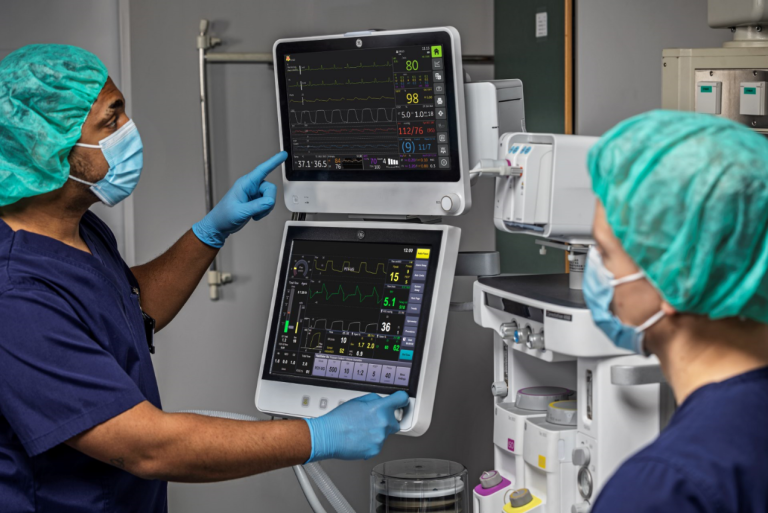
The adoption of new technology—and the accompanying support systems—often proceed more slowly in healthcare than other sectors. When it comes to anesthesia monitoring, many clinicians stand by decades-old methods, despite more recent evidence demonstrating patient safety advantages associated with objective monitoring. A lack of awareness of technological advances and institutional buy-in to make these systems available also contribute to slow uptake. Let's look at the current recommendations and consider how raising awareness can improve usage.
Professional guidelines recommend objective monitoring
In 2023, the American Society of Anesthesiologists published eight recommendations on the monitoring and antagonism of neuromuscular blockage, including the following:
- "When neuromuscular blocking drugs are administered, we recommend against clinical assessment alone to avoid residual neuromuscular blockade, due to the insensitivity of the assessment."
- "We recommend quantitative monitoring over qualitative assessment to avoid residual neuromuscular blockade."
- "When using quantitative monitoring, we recommend confirming a train-of-four ratio greater than or equal to 0.9 before extubation."1
These recommendations follow from 1950s-era anesthesia monitoring research, which introduced peripheral nerve stimulators (PNS). The more recent move toward objective monitoring seeks to reduce residual paralysis rates in the post-anesthesia care unit (PACU), which have remained stubbornly high.1
Many factors have contributed to this slow uptake, including a lack of portable and reliable monitoring. All patients respond differently to anesthesia drugs, and clinicians may perform subjective assessments—such as five-second head lift to evaluate residual blockade. However, some patients can maintain a five-second head lift even with residual paralysis, which may contribute to an unreliable assessment.1
Residual paralysis can lead to risks for the patient, including upper airway obstruction, aspiration, and a prolonged stay in the PACU.1 Over the past 70 years, mounting evidence has demonstrated that real-time quantitative train of four monitoring can prevent residual block.
History of neuromuscular transmission (NMT) monitoring
Decades ago, studies brought to light the risks of residual paralysis and how to assess for it. Yet, early technology was far too bulky to incorporate into busy operating rooms, leading to a reliance on qualitative assessments. A 1954 study first identified the risk of residual paralysis, leading to clinicians using PNS and clinical assessments to look for patients with residual paralysis.1,2
For decades, a PNS was the most objective tool for determining the level of residual block; however, it measures muscle response, making it subject to inaccuracy. To address this shortcoming, generations of anesthesiologists have complemented PNS with subjective responses, such as a five-second head lift, grip strength, respiratory measures, or four "visibly equal twitches" with PNS. Unfortunately, multiple studies have shown that patients can perform some of these assessments with a TOF ratio as low as 0.40.1,3
The concept of using TOF to assess neuromuscular block has been around since a study released in 1970.4 Yet, it's taken longer to develop the technology to apply this measure in clinical practice. Mechanomyography (MMG) and electromyography (EMG) could reliably measure a TOF ratio in a lab, but the machines were bulky and time-consuming to set up, making them unsuitable for busy operating rooms.
A breakthrough came in the late 1980s with the introduction of acceleromyography (AMG), which provided reliable, portable train of four monitoring. This equipment quickly became the "clinical gold standard."5
Monitoring became more routine, and researchers and clinicians refined definitions of residual paralysis. The ideal TOF ratio changed from <.70 in the 1980s and 1990s to <.90, which is the standard today. During this period, sugammadex, a reversal agent with few patient side effects, hit the market. Sugammadex could reliably reverse the effects of NMBDs. However, dosing works differently for all patients, so quantitative monitoring is still needed to ensure full reversal of the NMBDs effects.1
The advent of portable EMG devices in 2019 accelerated the efficacy of quantitative monitoring equipment.6 These machines, quick to set up and easy to use, overcome some limitations of AMG monitoring. EMG monitors measure and record the electrical signals in the muscular membrane at the neuromuscular joint—the site of NMBD action. EMG does not require mobilization of the thumb and is more reliable than AMG, which is known for overestimating the TOF ratio.6
These advances have made it easier to identify patients with residual paralysis and proactively prevent complications, thereby enhancing patient safety.
How these advances look in practice
A 1995 study evaluated the NMT monitoring practices of one institution, the anesthesiology department of Avicenne Hospital in Paris, France, and tracked the uptake of new technology among clinicians over a decade. Their experience helps explain the slow pace at which clinicians adopt guidelines (if they do so at all), despite published evidence.7
Their initial study examined residual paralysis in surgical patients who received an NMBD, specifically those with a TOF ratio <.70 (the standard at the time), noting whether or not the patient had received an antagonist. They found that 42% of patients had a TOF ratio <.70 in the recovery room, a signal to focus on changing practices and attitudes toward monitoring and reversing neuromuscular block. The researchers first added NMT monitoring to all operating rooms, and then eventually added AMG devices, and observed the outcome.
Over the study period, Avicenne Hospital evaluated practices and instances of inadequate recovery at three time points: in 2000, 2002, and 2004. They allowed anesthesiologists to choose whether to use the monitoring equipment or antagonists to document real-world clinical practice. The use of NMT monitors increased from 2% to 60% during the study time frame, and the number of patients presenting with a TOF ratio <.90 decreased from 62% to 3.5%. Patients with a higher TOF ratio were less likely to have had monitoring during surgery. The study authors concluded that the dose of NMBDs and incidence of residual paralysis decreases with NMT monitoring, and the use of reversal agents is best accomplished with monitoring. Although the results are encouraging, 40% of patients went without NMT monitoring.
Increasing awareness of advancements in monitoring
This reluctance to adopt readily available new technology persists today, even as advances in quantitative monitoring devices underscore their use in practice. NMT monitoring has long aided anesthesiologists and helped patients recover safely and effectively. From the early days of TOF monitoring, by observing visible twitches, to measurements at the site of action for neuromuscular blocking drugs, advances in technology and usage enable drastic reductions in inadequate PACU recovery and the associated risks and costs.
Increased awareness of the capabilities of the latest technology and how they can complement, rather than hinder, OR workflows can aid in uptake. Having a champion to explain the technology as well as potential cost savings by reducing complications from residual neuromuscular blocks can help spread the awareness from the department to institution decision makers. These technological advances provide anesthesiologists with a reliable, simple, and increasingly available way to monitor patient recovery, enhance workflows by getting patients into the PACU, and helping improve patient safety with an easy-to-use monitoring solution.
Resources:
1. Thilen SR, Weigel WA, Todd MM, et al. 2023 American Society of Anesthesiologists practice guidelines for monitoring and antagonism of neuromuscular blockade: a report by the American Society of Anesthesiologists Task Force on Neuromuscular Blockade. Anesthesiology. 2023; 138(1):13-41. doi:10.1097/ALN.0000000000004379
2. Beecher HK, Todd DP. A study of the deaths associated with anesthesia and surgery: based on a study of 599, 548 anesthesias in ten institutions 1948-1952, inclusive. Annals of Surgery. July 1954; 140(1): 2–35. doi.org/10.1097/00000658-195407000-00001
3. Kopman AF, Yee PS, Neuman GG. Relationship of the train-of-four fade ratio to clinical signs and symptoms of residual paralysis in wake volunteers. Anesthesiology. April 1997; 86(4): 765–771. doi.org/10.1097/00000542-199704000-00005
4. Ali HH, Utting JE, Gray C. Stimulus frequency in the detection of neuromuscular block in humans. British Journal of Anaesthesiology. November 1970; 42(11): 967-978. doi:10.1093/bja/42.11.967
5. Lee W. The latest trend in neuromuscular monitoring: return of the electromyography. Anesthesia & Pain Medicine (Seoul). 2021; 16(2): 133-137. doi:10.17085/apm.21014
6. Nemes R, Lengyel S, Nagy G, et al. Ipsilateral and simultaneous comparison of responses from acceleromyography- and electromyography-based neuromuscular monitors. Anesthesiology. October 2021; 135(4): 597-611. doi:10.1097/ALN.0000000000003896
7. Baillard C, Clec'h C, Catineau J, et al. Postoperative residual neuromuscular block: a survey of management. British Journal of Anaesthesiology. November 2005; 95(5): 622-626. doi:10.1093/bja/aei240









